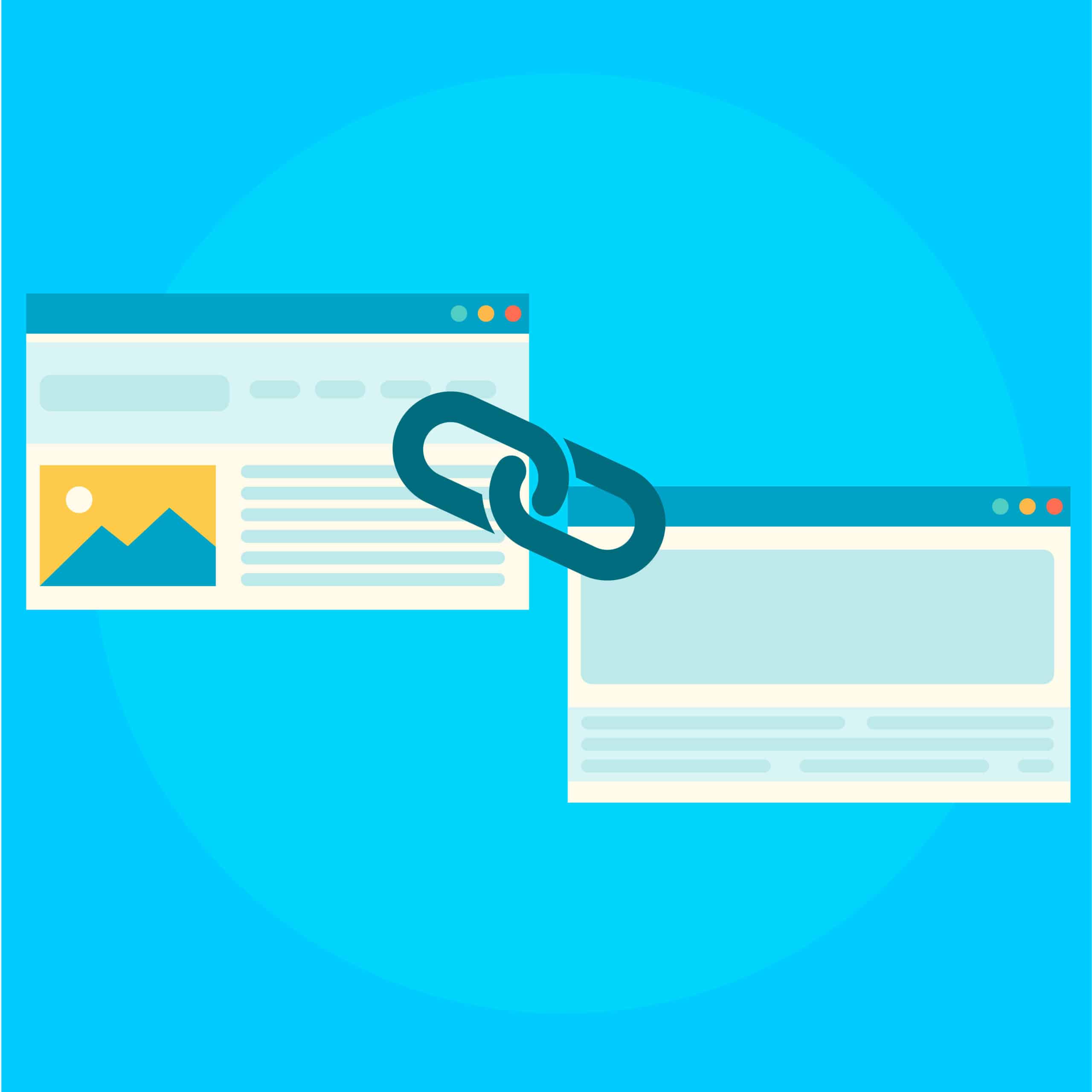What is a backlink?
Backlinking occurs when someone links to your website or vice versa. If you link to theirs, you are creating a backlink for them. When they link to your website, they are creating a backlink for you. For example, this phrase links to our local seo page, so it now has a backlink from us.
Why do they matter?
Backlinks are a crucial component of your business website’s SEO (Search Engine Optimization). They help to establish your company’s authority while fostering an environment where additional credible industry sources “vouch” for the credibility of your own company’s website.
Backlinks attract search engines. In other words, Google, for example, considers a backlink as a qualifying factor in determining your website’s credibility. Sixty-eight percent of online experiences begin with a search engine, so it stands to reason that the more backlinks, or qualifying factors, your business web pages accrue, the greater the likelihood that you will rank higher in search engine results. This means your website will attract greater organic (or free) search traffic.
Backlinks establish greater discoverability for your company web pages. Search engines function by revisiting popular pages in order to check for new links. If your company website pages are gaining backlinks from prominent pages, your content will be discovered at a much faster rate.
Backlinks are a great means of organic traffic referral. The primary purpose of a backlink is to direct users to resources which are useful and relevant to their search queries. This is also the reason that backlinks are clickable because when a user clicks on your website link, you automatically gain free (organic) traffic based on referral. This is crucial because the average cost of buying a link is $361.44. “Organic” means more cash in your pocket.
There are good backlinks and there are bad backlinks.
Unfortunately, not all backlinks are good as they are based on variables such as utility and quality. Search engines value relevant backlinks as they are more likely to be clicked. For example, if a Jacksonville dentist has backlinks from three pages, but one is about short giraffes, one is about big and tall jumpsuits and the third pertains to cavities, then the third backlink is of greatest value because it is actually relevant. Anyone searching for a Jacksonville dentist likely isn’t looking on behalf of a short giraffe. This same logic applies to your website domain. Traffic at Jacksonvilledentistry.com is going to be much more likely to click on a Jacksonville dentist’s website than traffic at shortgiraffes.com. You get the picture. Relevance is key.
Page authority works in correlation to organic traffic. If your business web pages have backlinks from solid web pages, those backlinks are considered a greater authority and will usually transfer more easily than backlinks from a weaker web page/authority. But, this isn’t ALWAYS the case as Google claims to equally split authority between all outbound links on web pages. Stay with me here because this is important. If your web page has backlinks from two pages, the first page carrying more outbound links than the second, the link from the second page transfers greater authority, all else being equal. Supposedly. I say this because there are innumerable patents and various methods for the process of assigning value to backlinks, especially with Google. In addition, a page’s authority can be boosted by contributing internal backlinks as well.
High-traffic page backlinks typically generate greater referral traffic than those from lower traffic pages. The question is whether or not high traffic page backlinks affect rankings on a more positive note than low traffic page backlinks. Simply put, the correlation is meager and the number of referring domain backlinks and web page authority are of greater value.
Prominently placed links are more likely to gain clicks, thus passing on more authority. In other words, colorful links in a bold font which are placed in main content areas of a page and contain verbiage which is attractive to users have a higher rate of clickability. This means they could generate a decent amount of page rank, but if a link consists of less desirable features that aren’t as attractive to a user, it becomes less likely to gain a high volume of clicks. This “weaker” link is less likely to pass on a decent amount of page rank. Keep in mind that you don’t want your link winding up in a site’s footer, so invest your time into other stronger options.
While “nofollowed” backlinks don’t typically affect page rank, they certainly can. Link building is a labor of love, requiring a tremendous amount of time and dedicated effort, therefore it makes more sense to go after “followed” links. Nofollowed links might still throw some SEO value your way, but don’t concentrate your efforts on those.
How to Spot a “nofollow” link: You’ll have to look at the code to identify a nofollow link. A follow link does not have a rel=”nofollow” attribute and will appear as: <a href=”https:/marlincs.com”>.
A NoFollow link has the rel=nofollow component and looks like: <a href=”https://marlincs.com” rel=”nofollow”>. To check for a nofollow link, right click it and click “Inspect.” Then check the code for that link for the inclusion of rel=”nofollow”. If there is no rel=”nofollow”, then you know you’re working with a follow link.
Why do nofollow links exist? Google uses links as a ranking factor in order to interpret which websites are linked to the most. The quality of a website is determined by the number of links, therefore higher ranking sites have more links. Unfortunately, underhanded SEO manipulators know that more links are all it takes for a website to wind up on page one of Google’s search engine. They tend to use “tricks” that go against Google terms and best practices, incorporating all kinds of junk simply for the purpose of gaining links. This method consists of leaving nonsensical comments on websites, the creation of junk websites and paying black market and higher-authority websites for links and backlinks. Google utilizes rel=”nofollow” in order to avoid the spread of spammy websites and bad backlinks. Website owners use rel=”nofollow” as a means of identifying advertising-related or paid links.
Anchor text: clickable words which form backlinks which affect Google’s original patent rankings. The correlation between anchor text and rankings is somewhat weak, but it still matters! However, when acquiring backlinks via outreach, the anchor text will be out of your hands when linking to your own business website. While no one likes to lose control, this is a benefit as it indicates that the link is of a better quality.
You can check backlinks in Google Search Console in order to learn about your company website’s performance and organic search traffic. The good news is that it’s free to do this and you need only to sign up for your free account then verify your website ownership. Next, click “links”. There is a number which reflects the total number of authentic backlinks to your website listed under “external links”. Below that number, you will see “top linked pages”, “top linking sites” and “top linking text”. You can easily view the most linked pages on your company website, the sites with the most backlinks to your company website and the most used anchors when linking to your company website. We advise beginning with “top linked pages” followed by a click on any URL in order to learn of the various websites linking to a given page. You can also click on any site to see which pages are linking to that page.
You can also check backlinks for a website you don’t own using a third-party backlink checker. Ahrefs offers a free backlink checker where you simply enter a URL and click “check backlinks.” The total number of referring domains and backlinks will appear in addition to the top 100 backlinks. Each will contain information such as the anchor and surrounding link text, traffic, strength of linked pages and the linking website and referring page.
You can acquire more backlinks by creating them, building them or earning them. When people discover your business website content (blog posts, for example) via social media, search engines, etc. and link to your page, you’ve officially earned a backlink. Earned backlinks are organic (free). When you create authentic, relevant content on your business website which compels people to want to link to it, you improve your chances of earning more backlinks.
Created backlinks are formed by manually adding links to your business websites from other sites. Every time you leave a blog comment or reply to a forum thread, for example, you can create a backlink.
You can build links by requesting other website owners to link to your company website pages. In fact, 73.6% of domains have reciprocal links, therefore, if you link to certain sites, there’s a good chance they will link to you in return. You can also:
- Offer to guest blog for another website.
- Suggest your working link as a replacement for relevant dead links on other websites.
- Ask authors to make the mention of your brand clickable if they are mentioning your brand in an unlinked fashion.
In closing: There is a direct correlation between backlinks and search engine ranking but not all backlinks are created equal. Variables such as placement, relevance and more, play a role in the utility and quality of a link. Hard work always pays off in the end because easy-to-obtain links won’t be nearly as valuable as the ones you work for.



